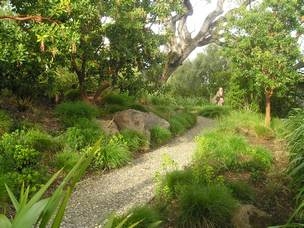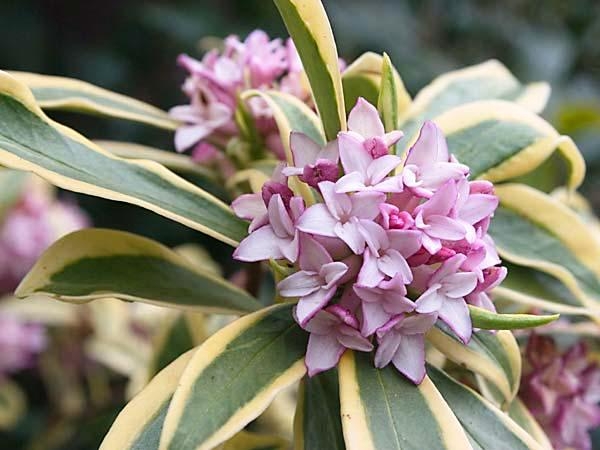In February the landscape stirs to life. Well, not in Minnesota or even Tahoe but around here the plums, tulip magnolias , manzanita, forsythia, flowering currants and quince are in full bloom. Other deciduous trees and plants that still look bare now are starting to grow new roots deep underground. It’s time to plan this year’s garden. Think about how you can blend artistry with ecology.
A landscape developed with 
Your goal may be a more drought tolerant garden but what’s right for your site? What plants to use that are more likely to withstand disease and pest damage? How do you keep the soil healthy and what irrigation system should be installed to provide for the needs of the landscape in the most efficient way possible? Where do you put the compost bin so you can return garden waste and kitchen waste back to the garden while recycling nutrients within the landscape? There are many components in designing and installing a sustainable landscape that is right for you and your site.
Start with a smart design. Utilize permeable paving like gravel or pavers the help manage runoff, giving the soil more time to absorb rainfall and recharge the ground water. Maybe you need a rain garden or small planted basin to catch and filter rainwater and keep it onsite.
Group plants in your garden according to their water needs. Some maybe can survive on rainfall alone after their second or third season while the perennial beds and vegetable garden will require a different schedule. Water slowly, deeply and infrequently so there is no runoff. Water in early morning or evening to maximize absorption.
Plant deciduous trees to provide cooling shade in the summer and allow sunlight to warm the house in winter. Trees and shrubs clean the air of nitrogen, sulfur dioxide, ozone and carbon monoxide and breathe in carbon dioxide ( a major greenhouse gas) , use the carbon to build mass, then exhale oxygen. They retain more carbon than they lose so every tree you plant helps reduce your carbon footprint on the planet.
Feed and shelter birds, butterflies and other wildlife in your landscape. Plant perennials such as echinacea, lavender, penstemon or salvia and other natives to attract pollinators like bees and hummingbirds. Plant flowers that attract beneficial insects to help control harmful insects and use organic pesticides.
Make your soil a priority by adding compost each year. Mulch your soil to keep down weeds and conserve water and use natural fertilizers like manures or fish emulsion that feed the soil. Compost the green and brown waste your garden produces like fallen leaves, weeds without seeds, grass clippings, spent flowers and vegetables.
Stay ahead of weeds, pulling them before they set seed and spread.
Take steps to develop a beautiful landscape that is right for you and your site and make your corner of the world contribute to the larger landscape around you.

 When do they occur each year? Phenology is a real science that has many applications. In farming and gardening, phenology is used chiefly for planting times and pest control. Certain plants give a cue, by blooming or leafing out, that it’s time for certain activities, such as sowing particular crops or insect emergence and pest control. Often the common denominator is the temperature.
When do they occur each year? Phenology is a real science that has many applications. In farming and gardening, phenology is used chiefly for planting times and pest control. Certain plants give a cue, by blooming or leafing out, that it’s time for certain activities, such as sowing particular crops or insect emergence and pest control. Often the common denominator is the temperature.  es and severely damaged another. About 60% of the Bonny Doon Ecological Reserve burned. It’s amazing to see the recovery already taking place. The bracken ferns came first, followed by the endangered Bonny Doon manzanita some of which have sprouted from their bases while 6" tall starts from seed are everywhere. The burned gnarled trunks rendered the landscape otherworldly and magical. Pockets of manzanitas that were spared by the fire were in full bloom dripping with clusters of delicate, white urn-shaped flowers. This manzanita is endemic to the Santa Cruz sandhills and does not occur anywhere else on the planet. Did you know that manzanita leaves are still used in Russia in the tanning industry due to their high tannic acid content?
es and severely damaged another. About 60% of the Bonny Doon Ecological Reserve burned. It’s amazing to see the recovery already taking place. The bracken ferns came first, followed by the endangered Bonny Doon manzanita some of which have sprouted from their bases while 6" tall starts from seed are everywhere. The burned gnarled trunks rendered the landscape otherworldly and magical. Pockets of manzanitas that were spared by the fire were in full bloom dripping with clusters of delicate, white urn-shaped flowers. This manzanita is endemic to the Santa Cruz sandhills and does not occur anywhere else on the planet. Did you know that manzanita leaves are still used in Russia in the tanning industry due to their high tannic acid content?.jpg)
 ngland called Rebecca has the same sweetly scented pink flowers but the leaves are more vividly variegated than the original. The stripes are wider and more buttery yellow and the flowers are a softer shell pink. These gorgeous little shrubs get a bad name for being finicky to grow. Less is more when it comes to their care. They thrive in partial shade in humus-rich soil with good drainage. Don’t keep them soggy during the summer or they succumb to crown and root rot. They don’t transplant well but are quite deer resistant. Daphne are not long lived, usually lasting for 8-10 years but what a life they live.
ngland called Rebecca has the same sweetly scented pink flowers but the leaves are more vividly variegated than the original. The stripes are wider and more buttery yellow and the flowers are a softer shell pink. These gorgeous little shrubs get a bad name for being finicky to grow. Less is more when it comes to their care. They thrive in partial shade in humus-rich soil with good drainage. Don’t keep them soggy during the summer or they succumb to crown and root rot. They don’t transplant well but are quite deer resistant. Daphne are not long lived, usually lasting for 8-10 years but what a life they live.